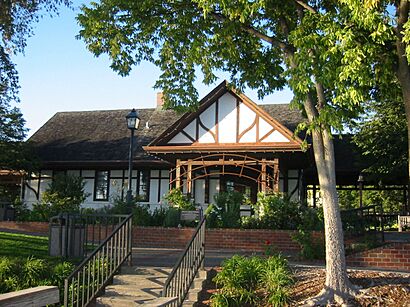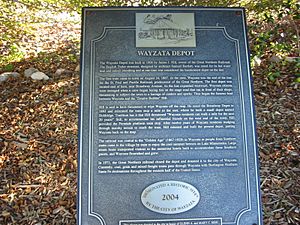Wayzata station facts for kids
Quick facts for kids
Wayzata station
|
||||||||||||||||
|---|---|---|---|---|---|---|---|---|---|---|---|---|---|---|---|---|

The Wayzata Depot as seen from the docks on Lake Minnetonka
|
||||||||||||||||
| Location | 402 East Lake Street Wayzata, Minnesota 55391 |
|||||||||||||||
| Coordinates | 44°58′7″N 93°31′3″W / 44.96861°N 93.51750°W | |||||||||||||||
| Former services | ||||||||||||||||
|
||||||||||||||||
|
Great Northern Railway Depot
|
||||||||||||||||
| Lua error in Module:Location_map at line 420: attempt to index field 'wikibase' (a nil value). | ||||||||||||||||
| Built | 1906 | |||||||||||||||
| Architect | Samuel L. Bartlett | |||||||||||||||
| Engineer | A.H. Hogeland | |||||||||||||||
| Architectural style | English Tudor Revival | |||||||||||||||
| NRHP reference No. | 81000322 | |||||||||||||||
| Added to NRHP | July 7, 1981 | |||||||||||||||
The Wayzata station, also known as the Great Northern Railway Depot, is a cool old train station in Wayzata, Minnesota, United States. It was built by the Great Northern Railway and served as a busy train stop from 1906 until 1971. You can find it right by Lake Minnetonka in downtown Wayzata, with steps leading down to the water.
Even though passenger trains don't stop here anymore, the BNSF Railway still uses the tracks that run through Wayzata today. The station was designed in a special style called English Tudor Revival by an architect named Samuel L. Bartlett. Because it's so important to history, it was added to the National Register of Historic Places in 1981. In 1972, the Burlington Northern Railway gave the depot to the city. Now, it's home to both the Wayzata Historical Society Museum and the Wayzata Area Chamber of Commerce.
Contents
The Story of Wayzata Station
The first railroad, called the Saint Paul and Pacific Railroad, arrived in Wayzata on August 24, 1867. This was a very exciting time! The first train station was a few blocks east of where the current one stands. Back then, the train tracks were laid right on Lake Street, which was the town's main road.
Early Challenges with the Railroad
When the railroad wanted to extend its tracks further west, people in Wayzata were not happy. They worried that trains would shower their businesses with cinders and sparks. Even though the railroad didn't listen, it helped the town grow. It connected local farmers to big city markets and made Wayzata a popular spot for Lake Minnetonka's growing tourism industry.
In 1879, a famous businessman named James J. Hill bought the railroad and renamed it the Saint Paul, Minneapolis, and Manitoba Railway (StPM&M). A few years later, Wayzata became an official village. One of the first things the village council did was try to move the train tracks away from downtown. They passed a rule in 1883 saying the tracks had to move 300 feet (91 m) north. But James J. Hill, who was in charge of the railroad, ignored them.
The Big Fight and a New Station
The village council decided to take the railroad to court in 1889. Hill argued that he had the law on his side. He even threatened to move the station almost a mile east of town if the lawsuit continued. In 1891, the Minnesota Supreme Court agreed with Wayzata. They said the railroad was illegally using Lake Street for its tracks.
Just as he promised, Hill took down the old station. He moved it to a flat area under what is now the Bushaway Road railroad bridge. He even renamed the new station "Holdridge," which meant Wayzata was literally taken off the train map!
By 1905, the village council had had enough of the fight. They voted to make peace with the railroad, which was now part of Hill's Great Northern Railway. Hill responded by ordering a brand new station to be built. This new station was placed near Wayzata's downtown, right on the shores of Lake Minnetonka. When it was finished in 1906, people said it was the "handsomest" station on the entire Great Northern line.
End of Passenger Service
Trains regularly stopped at the depot until 1958. After that, it became a "flag stop," meaning trains would only stop if someone requested it. In 1970, the Great Northern Railway joined with other railroads to become the Burlington Northern Railroad. Soon after, in 1971, Amtrak took over most passenger train services in the U.S. This meant all passenger service to and from Wayzata ended.
Since the building was no longer needed for trains, Burlington Northern gave the depot to the city of Wayzata in 1972. The building was later fixed up and added to the National Register of Historic Places in 1981. Today, the depot is shared by the Wayzata Area Chamber of Commerce and the Wayzata Historical Society. The Historical Society opened a museum inside the old waiting room in 2001. In the summer, you can even ride the historic Minnehaha steamboat from a dock next to the depot!
What Does the Station Look Like?
The Wayzata Depot was designed by Great Northern architect Samuel L. Bartlett. He used a style called English Tudor Revival architecture. This style often looks like old English country homes.
Outside the Depot
The outside of the building has a stucco finish, which is a type of plaster. It also has three gabled porticoes. A gable is the triangular part of a wall under a sloping roof. A portico is a porch leading to the entrance of a building. These porticoes have cool, curved half-timbering, which looks like wooden beams on the outside walls. The original lead glass windows are still there, adding to its historic charm.
Inside the Depot
Inside, the depot's waiting room has porcelain tile walls and a shiny terrazzo floor. You can still see the original waiting room benches, a desk where the freight agent worked, and even the scales used to weigh passengers' luggage. For 1906, the building had very modern features like indoor plumbing and a water fountain, which were quite fancy for a non-city area.
The office area holds the Depot Agent's desk and the operator's desk, along with many old items. A ticket window connects the office to the waiting room, just like it did when people bought their train tickets. Behind the office is the baggage room, which still has its original wood plank ceiling.
Tiny Trains: The Garden Railroad
In September 2006, the Minnesota Garden Railroad Society (MGRS) set up a temporary garden railroad display at the depot. This was part of Wayzata's annual James J. Hill Days celebration. People loved seeing the miniature trains running through tiny landscapes!
Because of how popular it was, the City of Wayzata, the Wayzata Historical Society, and the MGRS decided to build a permanent garden railroad. The city approved the project in 2009, and it became Minnesota's first public garden railroad display. The MGRS now runs G scale model garden trains on weekends for everyone to enjoy.


